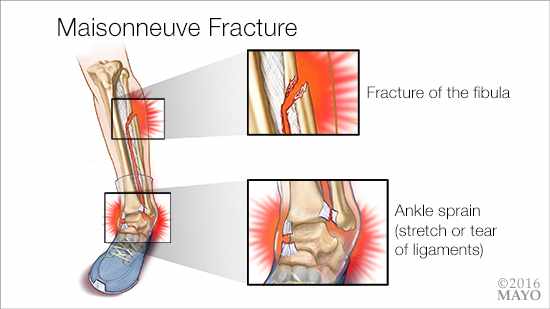-
Mayo Clinic Q and A: Untreated Maisonneuve fracture

DEAR MAYO CLINIC: What happens when a Maisonneuve fracture involving the tearing of all of the ligaments is not surgically repaired? What are the long-term effects of not treating the injury?
ANSWER: For this kind of complex ankle and leg injury, surgery often is necessary to stabilize the ankle joint and allow for proper healing. If a Maisonneuve fracture isn’t treated, the result can be long-term ankle instability and early-onset arthritis.
A Maisonneuve fracture is the result of two injuries that happen at the same time. The first is typically a very high break or fracture in the fibula — the smaller of the two bones between your ankle and your knee. The second is an ankle sprain — an injury that stretches or tears the tough bands of tissue, called ligaments, that help hold the bones of the ankle joint in place.
Maisonneuve fractures are most common in athletes who participate in sports such as skiing, gymnastics or dancing, where there is a risk of falling with the foot and leg hitting the ground at an awkward angle while they are rotating.
Symptoms of a Maisonneuve fracture include those you’d have with an ankle sprain, such as ankle pain, swelling, bruising and restricted range of motion. Symptoms also include ankle instability and pain higher in the leg at the site of the fibula fracture.
Diagnosing a Maisonneuve fracture can be challenging because it requires identifying several injuries. When health care providers suspect a Maisonneuve fracture, full-length X-rays of the fibula and the tibia (your other lower leg bone) are taken. Ankle joint, or mortise, X-rays are done, as well, to assess the joint damage and see if the bones in the joint are out of alignment.
X-rays taken while you aren’t bearing weight on your ankle may not reveal the full extent of a Maisonneuve fracture. Therefore, your health care provider may recommend that additional X-rays be taken while you put weight on your ankle. These images, also called stress films, can further assess possible damage to the ligaments in the ankle and evaluate the status of the ankle joint. In some cases, an MRI is used to assess the ankle joint, too.
If the images show a Maisonneuve fracture, but the bones of the ankle joint are still in their proper place, or just slightly out of alignment, and the stress films show only minor ankle instability, then surgery may not be necessary. In such cases, using crutches, along with a brace, cast or splint as the ankle and leg heal, followed by physical therapy to regain your range of motion, may be sufficient treatment.
When a Maisonneuve fracture involves significant ligament injury such as you describe, however, surgery is almost always required to stabilize the ankle joint and allow for proper healing. Depending on the specifics of the injury, your surgeon may place screws or other devices to hold the ankle joint in place while the ligaments heal. Screws may be removed when healing is complete, but that’s determined on a case-by-case basis.
Standard postoperative recovery typically includes keeping weight off the affected ankle for 6 to 12 weeks. Following this, physical therapy may be used to regain flexibility, strength and balance. The goal is for the patient to be able to return to full activity and to regain the function he or she had prior to the injury.
If the ankle joint is not positioned properly during the healing process, the joint may be at risk for developing arthritis. Eventually, that can lead to chronic ankle pain, tenderness, stiffness and loss of flexibility.
To ensure the long-term health of the ankle joint following this injury, it is important to have a Maisonneuve fracture thoroughly assessed, properly diagnosed and promptly treated. — Dr. William Cross III, Orthopedic Surgery, Mayo Clinic, Rochester, Minnesota







